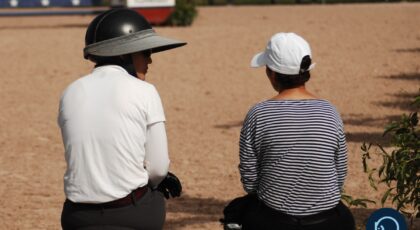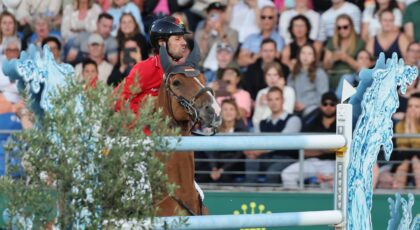Anyone who knows me well knows that I love numbers. They allow us to quantify performance and search for patterns within sport that may not be otherwise apparent. For this article, I wanted to look at the characteristics of horses and riders at the last three major international championships for show jumping (Rio 2016, WEG 2014, and London 2012).
By looking at the available data, certain trends become apparent which can give us insight into the current state of the show jumping sport at the highest level. These observations were compiled from the information provided in the FEI database, and thus the data is readily available to anyone who wants to do a similar analysis. Below I have highlighted some interesting data from the last three major games which provide insight into modern trends in show jumping.
Overview
To start, let’s examine some general information about the horses and riders who competed. Across the three major championships examined, a total of 219 different riders from 54 nations competed during at least once. During these same events, 267 different horses competed. If we look at just the Olympics, the following 11 countries qualified teams for both London and Rio:
- Australia
- Brazil
- Canada
- France
- Great Britain
- Germany
- Netherlands
- Switzerland
- Sweden
- Ukraine
- United States of America
Qualifying a team for consecutive Olympics is no easy feat, so it speaks to the dominance of the above nations in being able to qualify teams for the largest competition in our sport. To do so, the nations must put the correct horse-rider combinations together at the correct times (qualifying competitions) to ensure a berth in the Olympics. Although there is always a level of chance associated with this sport, the above nations can be used as models for other nations aspiring to consistently compete teams at the top of the sport.
For individual rider characteristics, show jumping has a wide range of rider ages that compete at the highest levels with top results. For example, in London 2012, the youngest rider was 18 years old (Reed Kessler; USA) and the oldest was 65 (Ian Millar; CAN). Furthermore, equestrian is unique in that males and females compete against each other. However, there was not an equal gender split at either Olympics.

(Reed Kessler and Cylana/©Horse Network)
For Rio 2016, 17.3 % of riders were female, and in London 2012, 18.7 % of riders were female. This statistic is certainly one to monitor as the sport continues to develop!
Horse Age
The average age for a horse competing at a major championship was 11.5 years old. The percentage of horses at each age for major championships are shown in the figure below. Note that the most common ages are 10 and 11 for championship horses.

One may initially look at these ages and assume that horses peak athletically around the age of 10 or 11, and after 12 years, their ability to reach championship form is decreased. Although this may be the case, there are a number of other factors to consider:
- Many horses are sold after reaching a major championship. If they are sold to another rider not competing at the championship level, the horse will never reach this level again at an ‘older age’
- Training-induced injuries become more prevalent as horses age
- Riders tend to preserve older horses, and may perceive the championship format to be too physically taxing on their senior mounts
To further examine horse age, we can break it down by sex. Although data on the topic is limited, it is very likely that based on the sex of the horse, it will reach championship form at different times during its lifespan (due to differences in hormones, anatomy, and so on).
In the figure below, it is readily apparent that stallions were older than geldings and mares at both Olympics. One possible explanation for this is that good quality stallions may be kept for top level riders to continue to demonstrate the horse’s breeding potential. Conversely, geldings and mares may be sold to younger or less competitive riders to aid in their development. Interestingly, the trend of stallions being older was not apparent in WEG 2014.

Horse Sex
You don’t have to be in the horse world long to hear different experts discuss why they prefer mares, stallions or geldings. The discussion usually relates back to stories which have produced the currently held notions of these individuals. Although there may be some good reasoning for their decisions, does the sex of the horse actually matter when looking at which horses reach the top of the sport?
Below is the breakdown of stallions, geldings and mares at the last three major championships. It is clearly apparent that 1 in 2 horses at these events were geldings, while mares were the least common (1 in 5 horses are mares). Although each sex has produced dominant horses over the history of the sport, this data is worth considering when gambling on a horse to invest in for the future.

Studbook Registration
The average percentage of championship horses registered to different studbooks are shown in the figure below. It is interesting to note that over 50% of horses competing were Selle Francais (SF), Belgian Warmbloods (BWP) or Dutch Warmbloods (KWPN). This speaks to the dominance of these breeding programs, and certainly provides riders looking for championship horses a great place to start their search for the next star.
(Studbook Key: ZANG: Zangersheide; WESTF: Westphalian; SWB: Swedish Warmblood; SF: Selle Francais; SBS: Belgian Sport Horse; OS: Oldenburg; KWPN: Dutch Warmblood; ISH: Irish Sport Horse; HOLST: Holsteiner; HANN: Hanoverian; BWP: Belgian Warmblood; AES: Anglo-European)

Last thoughts…
Of the 219 riders who competed during at least one of the last three major championships, only 18 riders competed at all three. This statistic demonstrates how difficult it is to keep top riders well mounted, and to have everything line up to allow them to compete at major games. A lot of very good riders did not meet this criteria.
Of the 267 horses who competed during the last three major championships, only 2 competed at all three: Nino des Buissonnets (SUI) and VDL VERDI TN (NED). Again, this speaks to the difficulty of maintaining a championship level horse for more than four years.
About the Author

(Courtesy of the author.)
Dr. Tim Worden has worked as a sport scientist with numerous FEI-level show jumping riders. He has a PhD in biomechanics and specializes in applying human high-performance training techniques to horses.


 September 8, 2016
September 8, 2016 

























